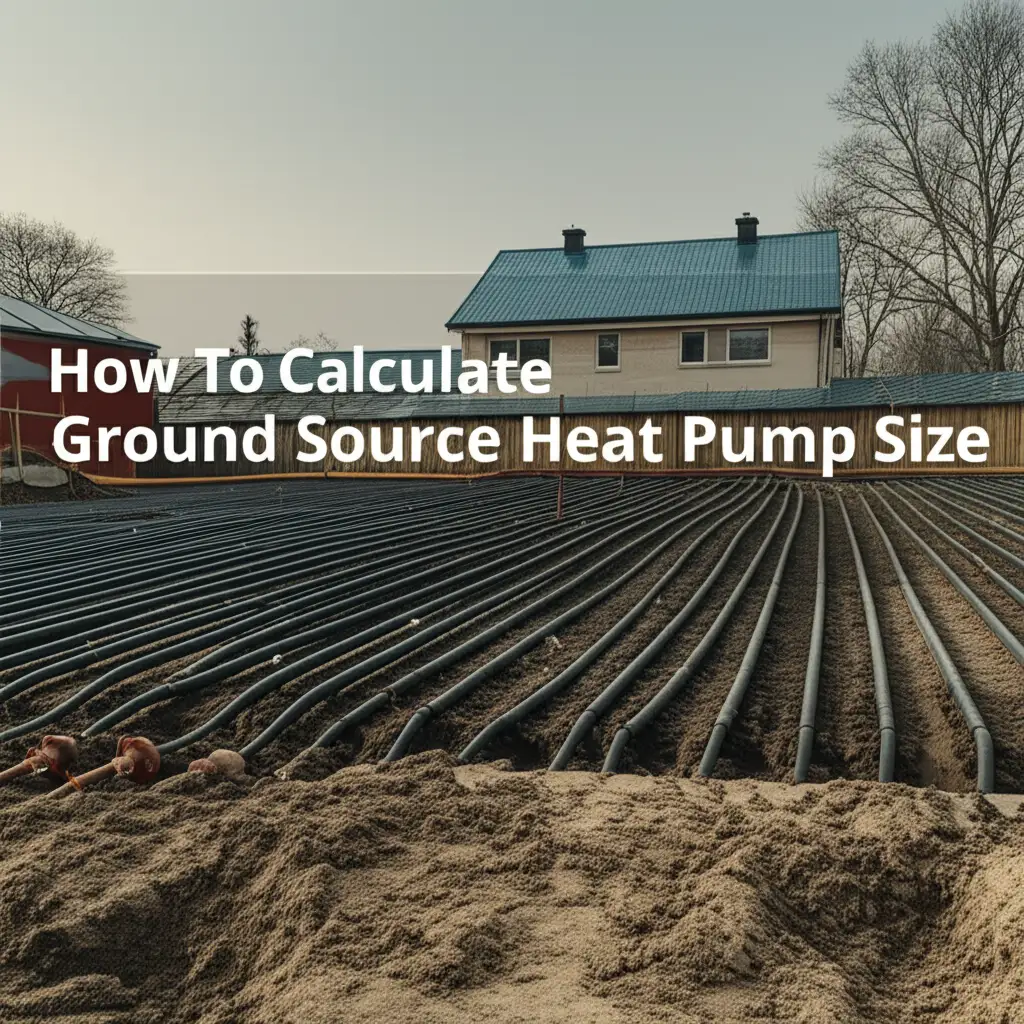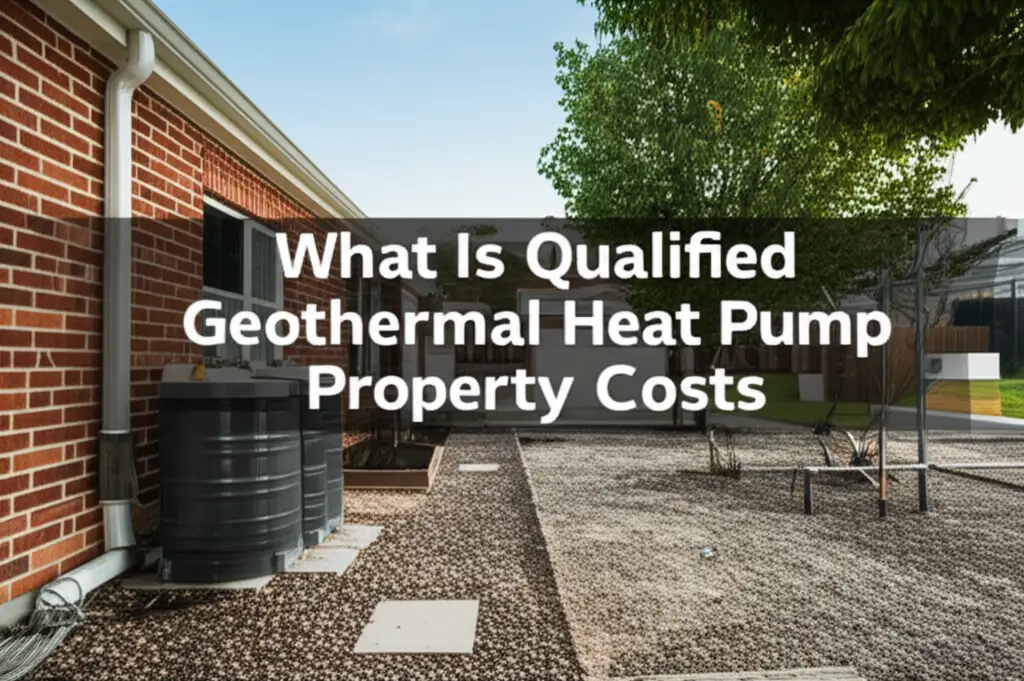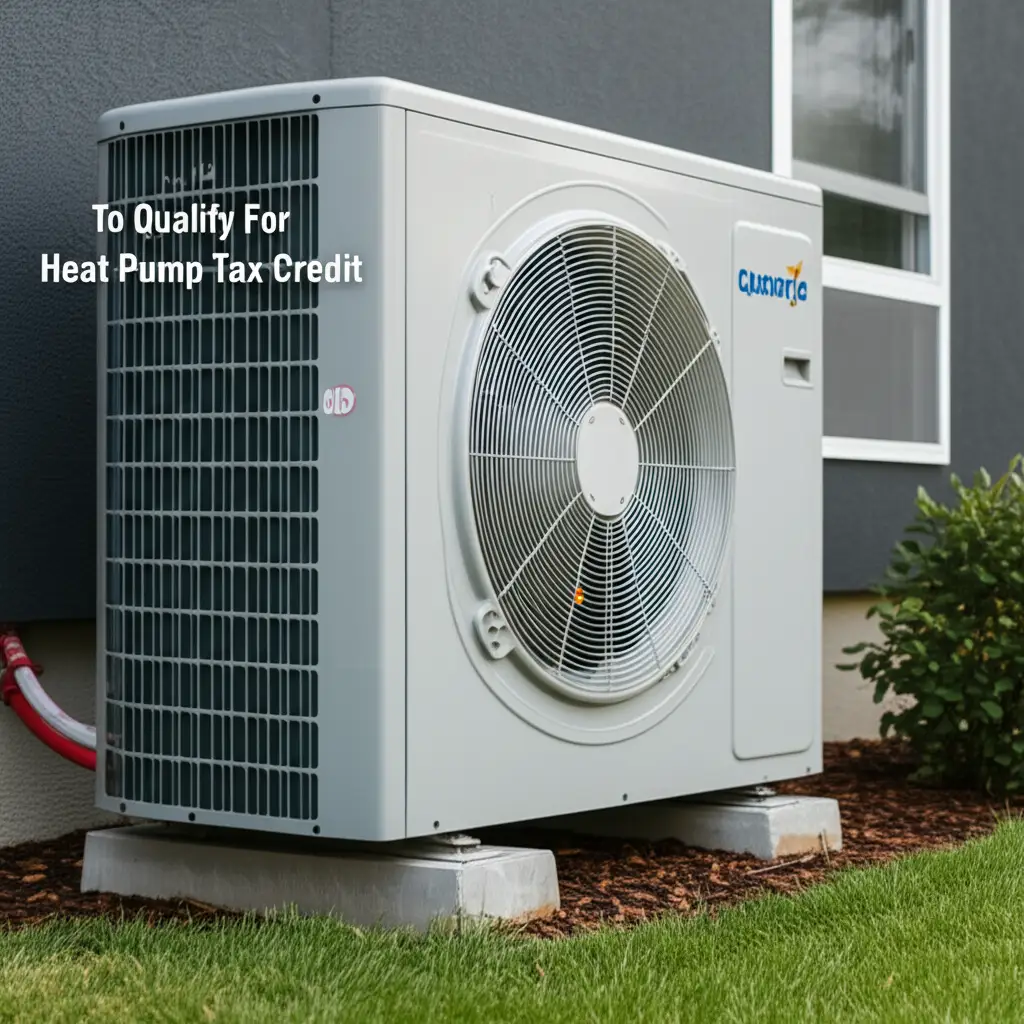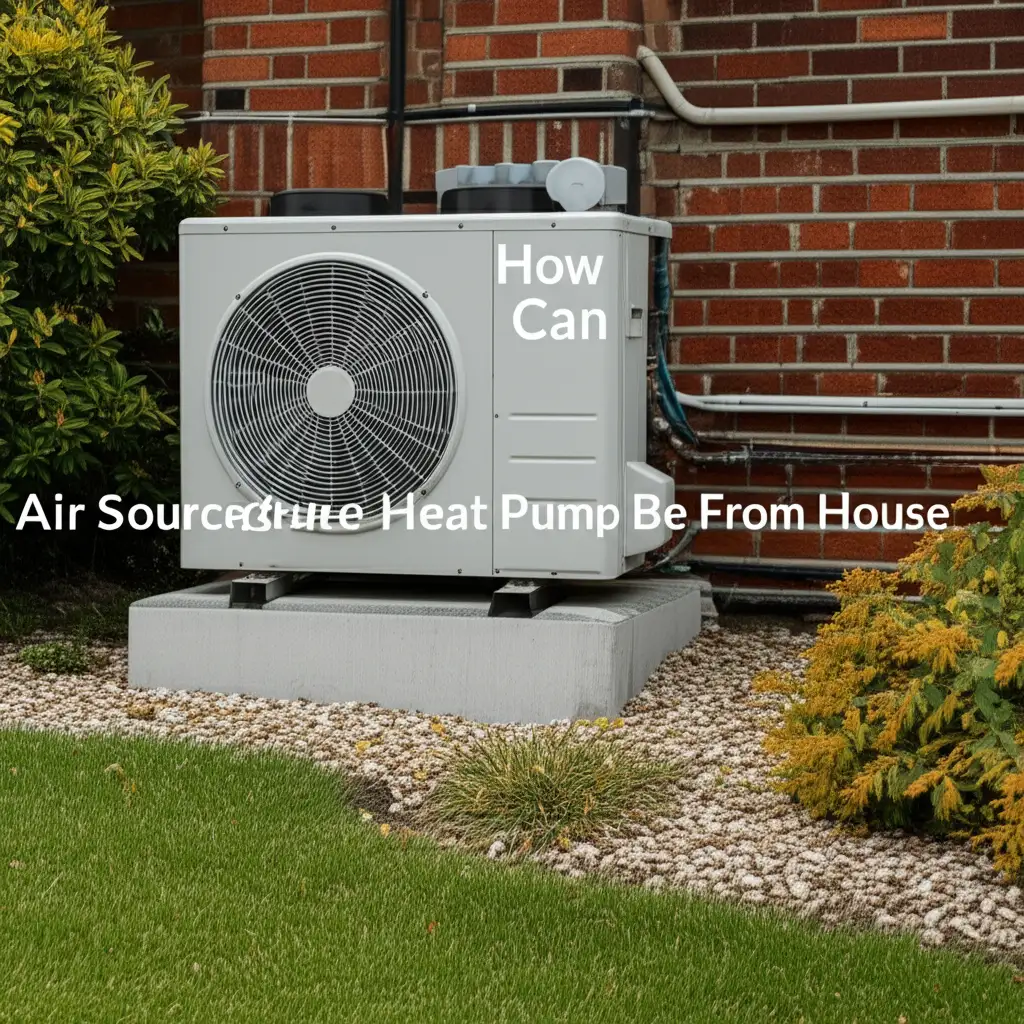· Todd Martin · Energy Efficiency · 16 min read
How To Calculate Ground Source Heat Pump Size

Ground Source Heat Pump Size: A Calculation Guide
Choosing the right heating and cooling system for your home involves important decisions. One of the biggest challenges is making sure the system has the correct size. When you want to calculate ground source heat pump size, you need precise information. A properly sized ground source heat pump (GSHP) delivers optimal comfort and significant energy savings. If the system is too small, your home will not stay warm or cool enough. If it is too big, it wastes energy and money. This article will help you understand the key factors and steps needed to properly size a ground source heat pump. We will look at heat loss, climate, and other essential details for an efficient system.
Takeaway
- Accurate GSHP sizing ensures comfort and saves energy.
- Heat loss calculation is the most critical step.
- Soil conditions and climate impact ground loop design.
- Professional assessment is vital for correct installation and performance.
You calculate ground source heat pump size primarily by determining your home’s total heating and cooling load. This involves a professional heat loss and gain calculation (like Manual J). You then match this load to the heat pump’s capacity, considering factors like local climate, soil thermal properties, and hot water demands.
Why Accurate Sizing Matters for Your GSHP
Properly sizing a ground source heat pump is not just a recommendation; it is a necessity. The right size system works efficiently. It keeps your home comfortable year-round. This leads to lower utility bills and a longer lifespan for your heat pump.
An undersized heat pump struggles to meet heating or cooling demands. It runs almost constantly during peak seasons. This causes discomfort, high energy consumption, and premature wear on components. Imagine your home never reaching the desired temperature on the coldest winter day or hottest summer afternoon. This is a common problem with an undersized unit.
On the other hand, an oversized heat pump also presents problems. It uses more electricity than necessary. It often cycles on and off too quickly, a process called “short cycling.” Short cycling prevents the system from running long enough to dehumidify the air properly in cooling mode. This leaves your home feeling clammy and uncomfortable. An oversized unit also costs more upfront. It might fail sooner due to increased wear and tear from frequent starts and stops. Investing in the correct size ensures you get the most out of your ground source heat pump. Proper sizing means your system operates as it should, delivering consistent comfort and maximum energy savings. It avoids the headaches and extra costs associated with an ill-fitting system.
Key Factors Influencing Ground Source Heat Pump Size
Several important factors directly affect the size of the ground source heat pump you need. These elements dictate how much heating and cooling capacity your home demands. Understanding them helps you grasp the complexities of GSHP sizing. You cannot simply guess or use a general rule of thumb.
First, your home’s local climate plays a significant role. Homes in colder regions need more heating capacity. Homes in hotter regions require more cooling capacity. The extremes of temperature in your area directly influence the heat pump’s required output. This affects the overall design of your system.
Second, the quality of your home’s insulation is critical. Well-insulated walls, attics, and floors reduce the amount of heat that escapes in winter and enters in summer. High-performing windows and doors also prevent heat transfer. A home with poor insulation loses heat quickly. This means it needs a larger heat pump to compensate. Conversely, a well-insulated home may need a smaller unit.
Third, the size and layout of your home matter. Larger homes naturally require more energy to heat and cool. The number of rooms, ceiling heights, and floor area all contribute to the total volume of air that needs conditioning. Even the number of occupants impacts the load. Each person generates body heat, which adds to the cooling load. You also need to consider your family’s daily habits. Do you prefer a very warm house in winter or a very cool house in summer? These preferences can influence the final calculation. Understanding these factors provides a solid foundation for calculating your specific ground source heat pump needs.
The Crucial First Step: Calculating Your Home’s Heat Loss
Calculating your home’s heat loss and heat gain is the most important step in sizing any heating or cooling system, especially a ground source heat pump. This process precisely determines how much energy your home loses in winter and gains in summer. You cannot select the right heat pump without this vital information. This calculation is often called a load calculation.
The industry standard for residential load calculations is the Manual J protocol from ACCA (Air Conditioning Contractors of America). A certified professional performs this detailed analysis. They do not just use square footage; they consider every aspect of your home. This includes the local climate data, such as average low and high temperatures. They measure every exterior wall, window, and door. They look at the U-value (insulation value) of all building materials. This includes walls, roofs, floors, and glass.
The calculation also accounts for air infiltration. Air leaks through cracks around windows, doors, and foundations allow conditioned air to escape. This uncontrolled airflow significantly adds to your heating and cooling load. The professional will also consider internal heat gains from appliances, lighting, and occupants. For example, a busy kitchen with cooking appliances generates a lot of heat.
Once all these factors are measured and entered into specialized software, the Manual J calculation produces a precise number. This number represents the total BTUs (British Thermal Units) per hour needed to heat and cool your home. Ground source heat pumps are sized based on these BTU requirements. Using a professional for this step ensures accuracy. This prevents expensive mistakes from oversizing or undersizing the system. It helps you accurately calculate what size heat pump you need and truly understand your home’s energy demands. Getting this right means your ground source heat pump will deliver optimal performance and energy efficiency. You can find more details on general sizing principles by reading about how to calculate the right size heat pump.
Understanding Ground Loop Design and Soil Properties
The ground loop is the part of the ground source heat pump system that interacts directly with the earth. Its design and the properties of your soil are fundamental to sizing the overall system. The ground loop extracts heat from the ground in winter and rejects heat into the ground in summer. Its effectiveness directly impacts the efficiency of your heat pump.
There are two main types of ground loop systems: closed-loop and open-loop. Closed-loop systems circulate a mixture of water and antifreeze through buried pipes. This liquid absorbs or releases heat. Open-loop systems, less common for residential use, pump water from a well, extract or reject heat, and then return the water to another well or surface water body. Most residential installations use closed-loop systems due to their lower environmental impact and consistent performance.
Within closed-loop systems, you typically find two configurations: horizontal and vertical. Horizontal loops are buried in trenches, usually 4-6 feet deep. They require a significant amount of land area. This makes them suitable for properties with ample space. Vertical loops involve drilling boreholes, often 150-500 feet deep. These are ideal for smaller properties or where land disturbance needs to be minimal. The choice depends on available land, soil type, and installation costs. Understanding how deep does ground source heat pump need to be is critical for vertical designs.
Soil thermal conductivity is a critical factor for ground loop design. Different soil types transfer heat at different rates. Clay soils generally have better thermal conductivity than sandy or dry soils. Water content in the soil also influences conductivity. Wet soil transfers heat more efficiently than dry soil. A professional installer performs a thermal conductivity test of your specific soil. This test determines how much heat can be exchanged per foot of buried pipe. This value directly influences the total length of piping needed for the ground loop. If your soil has low conductivity, you will need more pipe. This also means more drilling or trenching. Proper ground loop sizing ensures the heat pump always has a stable source or sink for heat, regardless of surface air temperatures. This directly affects the overall efficiency and lifespan of your system. You can explore more about pipe depths by reading about how deep are ground source heat pump pipes.
The Role of Coefficient of Performance (COP) and Energy Efficiency Ratio (EER)
When you look at ground source heat pumps, you will often see terms like Coefficient of Performance (COP) and Energy Efficiency Ratio (EER). These numbers are very important. They tell you how efficient a heat pump is at converting electricity into heating or cooling output. Understanding these metrics helps you choose the right unit after you calculate your home’s heat load.
COP measures a heat pump’s heating efficiency. It is the ratio of heating output (in BTUs) to the electrical energy input (in BTUs or watts) required to produce that heat. For example, a GSHP with a COP of 4.0 produces 4 units of heat energy for every 1 unit of electrical energy consumed. This means it is 400% efficient in converting electricity into heat. Higher COP values indicate greater efficiency. This translates directly to lower heating bills. Ground source heat pumps typically have very high COPs, often ranging from 3.0 to 5.0 or even higher. This makes them highly efficient for heating.
EER measures a heat pump’s cooling efficiency. It is the ratio of cooling output (in BTUs per hour) to the electrical power input (in watts) at specific operating conditions. A higher EER rating means the heat pump is more efficient at cooling. For example, an EER of 20 means that for every watt of electricity used, the unit provides 20 BTUs of cooling. Ground source heat pumps often have EER ratings that surpass traditional air conditioning systems significantly. This is because they exchange heat with the stable ground temperature, which is cooler than ambient air in summer.
Both COP and EER are crucial when sizing your ground source heat pump. A system with higher efficiency ratings can often meet the same heating or cooling load with a slightly smaller electrical input. This means lower running costs. When comparing different heat pump models, always look at these ratings. They help you determine how much electricity your ground source heat pump will use and its overall performance. A high COP and EER mean a more efficient system, which contributes to long-term savings. The unit’s capacity, typically measured in tons (1 ton = 12,000 BTU/hr), must align with your home’s calculated heat load. However, the COP and EER dictate how efficiently it delivers that capacity.
Steps to Estimate Ground Source Heat Pump Capacity
Estimating the required ground source heat pump capacity involves combining the knowledge of your home’s specific needs with the principles of how these systems work. While a professional will perform the final design, understanding these steps helps you grasp the process. You can better communicate with your installer.
First, you must have a clear understanding of your home’s total heating and cooling load. This comes from the detailed heat loss and gain calculation discussed earlier. This calculation gives you a precise BTU/hour requirement for heating in the coldest conditions and cooling in the hottest conditions. This is the foundation upon which all other sizing decisions are built. Do not skip this step or guess.
Second, consider the local climate. While the ground source heat pump relies on stable ground temperatures, the heat pump unit itself must handle the peak heating and cooling demands of your home based on external air temperatures. The colder your winters, the larger your heating load. The hotter your summers, the larger your cooling load. Ground source heat pumps are versatile and can often provide both heating and cooling. You can learn more about this capability by reading about can ground source heat pump be used for cooling.
Third, account for your domestic hot water needs. Many ground source heat pumps can provide a significant portion of your hot water using a desuperheater. This device captures waste heat from the compressor during cooling operation or pulls extra heat during heating cycles to preheat water. If you plan to use your GSHP for hot water, this slightly increases the overall load calculation. This helps optimize the system for year-round energy savings. Understanding what is ground source heat pump energy used for can help you factor this in.
Fourth, consider your specific soil conditions. As mentioned, the thermal conductivity of your soil determines the length of the ground loop needed. An initial estimate might suggest a certain heat pump capacity. However, if your soil has poor conductivity, the ground loop may need to be significantly longer. This impacts the overall system design and cost. You might need more boreholes or trenches to achieve the necessary heat exchange.
Finally, select a heat pump unit that matches your calculated BTU load and desired efficiency. Heat pump capacity is often expressed in “tons,” where one ton equals 12,000 BTUs per hour. For example, if your home needs 48,000 BTUs for heating, you would look for a 4-ton heat pump. Also, compare the COP and EER ratings to ensure you choose an energy-efficient model. Remember, this is an estimation guide. The final design of a ground source heat pump system, especially the ground loop, is complex. It requires specialized tools and expertise.
Why Professional Assessment is Non-Negotiable
While understanding how to calculate ground source heat pump size gives you valuable insight, attempting a do-it-yourself sizing and installation is highly discouraged. A professional assessment is not just a suggestion; it is absolutely essential for the success, efficiency, and longevity of your ground source heat pump system. This is an investment that demands precision.
Ground source heat pump design involves more than just a simple BTU calculation. Professionals use sophisticated software that accounts for detailed building characteristics, local geological data, and specific equipment performance curves. This software helps them optimize the ground loop size and configuration. They consider factors like borehole depth, spacing, and the specific thermal properties of the earth on your property. This level of detail ensures the ground loop can effectively handle the heat exchange required by the heat pump. Without this precise design, the system will not perform optimally.
A certified GSHP installer brings invaluable experience and expertise. They understand the nuances of various ground loop designs—vertical, horizontal, open-loop, and pond loops. They can advise on the best solution for your property based on soil conditions, available land, and budget. They also manage the drilling or excavation process, which requires specialized equipment and knowledge of local regulations. Trying to install your own ground source heat pump can lead to serious problems, including system failure or ground instability. For instance, knowing how deep do you need to drill for ground source heat pump is a complex engineering task, not a simple measurement.
Furthermore, professional installation ensures compliance with building codes and manufacturer warranties. Many warranties become void if the system is not installed by a certified technician. Professional installers also have the tools to properly charge the refrigerant lines and test the system for leaks. They can ensure the entire system integrates seamlessly with your existing ductwork or hydronic heating system. Mistakes in sizing or installation can lead to reduced efficiency, higher energy bills, and costly repairs down the line. It is far better to invest in a professional upfront. This ensures your ground source heat pump operates reliably and efficiently for decades. You can find out more about potential issues by reading about what can go wrong with ground source heat pump.
FAQ Section
Q1: What happens if my GSHP is too small?
If your ground source heat pump is too small, it will not meet your home’s heating or cooling needs. The system will run almost constantly, especially during peak temperature periods. This leads to higher electricity bills as it works harder. Your home may never reach the desired temperature, making it uncomfortable. Constant operation also causes premature wear and tear on components, leading to earlier breakdowns.
Q2: What happens if my GSHP is too big?
An oversized ground source heat pump cycles on and off too frequently. This “short cycling” wastes energy because the system uses a lot of power during start-up. It also reduces the system’s ability to dehumidify air, making your home feel clammy in summer. Oversized units are more expensive to buy and install. Their frequent starts and stops can also reduce their overall lifespan.
Q3: How long does GSHP sizing take?
A professional heat loss and gain calculation (like Manual J) can take a few hours for a typical home. The complete ground source heat pump sizing process, including ground loop design and proposal generation, typically takes several days to a week. This depends on the complexity of your property and the contractor’s schedule. This is a detailed engineering process.
Q4: Can I use an online calculator for GSHP sizing?
Online calculators provide only very rough estimates. They usually rely on simple inputs like square footage and general climate zones. They do not account for critical factors such as your home’s insulation levels, window quality, air infiltration, or specific soil thermal properties. For accurate ground source heat pump sizing, you must use a professional load calculation and ground loop design.
Q5: What is Manual J calculation?
Manual J is the industry standard protocol for determining a home’s heating and cooling load. It is published by ACCA (Air Conditioning Contractors of America). A Manual J calculation considers every detail of your home. This includes insulation, window types, local climate, and internal heat gains. It calculates the precise BTUs per hour needed for your HVAC system.
Q6: Do ground source heat pumps provide cooling?
Yes, ground source heat pumps provide both heating and cooling. In heating mode, they extract heat from the ground and transfer it into your home. In cooling mode, the process reverses: they extract heat from your home and transfer it into the cooler ground. This dual functionality makes them a versatile all-in-one climate control solution.
Conclusion
Calculating the correct ground source heat pump size is the single most important step in ensuring your home’s comfort and energy efficiency. We have discussed the critical factors, from understanding your home’s unique heat loss and gain characteristics to the crucial role of soil properties and ground loop design. While it is helpful to grasp these concepts, the complexity of a ground source heat pump system means professional expertise is indispensable.
A certified GSHP installer will perform a thorough load calculation and engineer a ground loop specific to your property. This precision guarantees your system operates at peak efficiency, delivering consistent heating and cooling while minimizing energy consumption and operational costs. Investing in a properly sized and installed ground source heat pump means investing in a comfortable, sustainable, and cost-effective future for your home. Do not leave this vital decision to chance. For a reliable and efficient ground source heat pump system, contact a qualified local GSHP designer and installer today. They will ensure your system is perfectly matched to your home’s needs for years to come.





